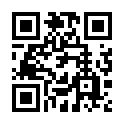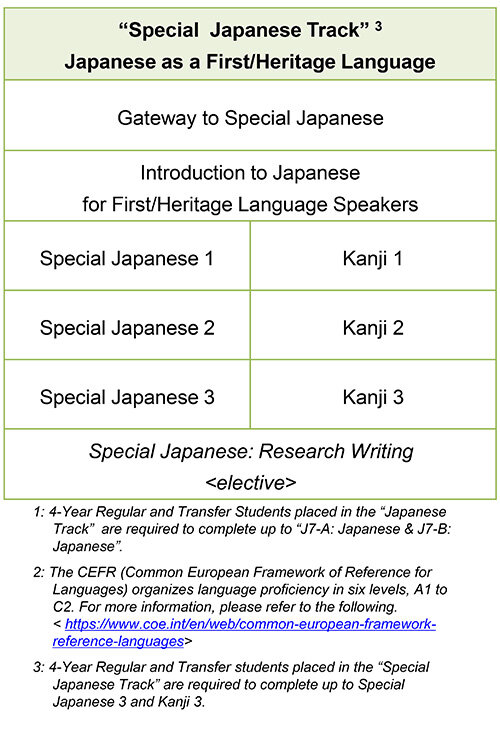Curriculum
The Right Course for Each and Every One of You
Students with diverse background come to ICU to learn Japanese. Every student has his/her needs and purposes, so JLP offers a variety of courses to cater for undergraduate students, exchange/one-year-regular students, and graduate students.
Japanese Track: Japanese as a Foreign Language
The Japanese Track

This track covers all language skills, and students are expected to actively participate in classes which are kept relatively small. There are tutorial sessions where students can receive individual attention.
Students will be placed in courses according to the placement test, which is conducted during the university orientation program.
Students without previous knowledge of Japanese are welcome to pursue a degree at ICU. However, in order to graduate from ICU, students must fulfill the graduation language requirement. The graduation requirement for the Japanese Track students is to complete up to J7-A: Japanese and J7-B: Japanese, which will be a maximum of 35 credits.
In addition to the Japanese course, students can take other courses offered in the College of Liberal Arts.

| Course Title | Goal (CEFR level) |
Course Description | Hours/ Week | Credits | Terms |
|---|---|---|---|---|---|
| J1: Japanese | Al | This course is targeting the CEFR A1 level of spoken and written Japanese. It focuses on communication activities relevant to the learners themselves and their immediate surroundings. | 10 | 5 | Spring & Autumn terms only |
| J2: Japanese | A2.1 | This course is targeting the CEFR A2.1 level of spoken and written Japanese. It focuses on interactive communication activities which learners encounter. | Every term | ||
| J3: Japanese | A2.2 | This course is targeting the CEFR A2.2 level of spoken and written Japanese. It focuses on communication activities relevant to social contexts which learners encounter. | |||
| J4: Japanese | B1.1 | This course aims to help students learn spoken and written Japanese for academic purposes through a variety of familiar topics about society and culture. The target level is CEFR B1.1. | |||
| J5: Japanese | B1.2 | This course aims to help students gain a foundation in spoken and written Japanese for academic purposes through topics on society and culture. The target level is CEFR B1.2. | |||
| J6: Japanese | B2.1 | This course aims to help students learn spoken and written Japanese for academic purposes through a variety of social subjects or quasi-professional topics. The target level is CEFR B2.1. | |||
| J7-A: Japanese | B2.2 | This course prepares students to participate in university lectures taught in Japanese. By studying various topics, students will acquire the Japanese language proficiency (listening, reading, discussion, and writing) required for university lectures and autonomous learning skills to improve these skills further. The target level is CEFR B2.2. |
4 | 3 | |
| J7-B: Japanese | B2.2 | This course prepares students to participate in university lectures taught in Japanese. Students will learn how to write academic reports in Japanese and acquire the basics of academic writing required in university courses through report-writing activities on their chosen topics. They also learn how to make formal presentations. The target level is CEFR B2.2. |
2 | 2 | |
| Advanced Japanese: Listening and Discussion (elective) | This course places emphasis on listening and speaking proficiencies. Learners who have reached the CEFR B2.2 level will further develop their academic skills through listening and discussion. |
2 | 1 | Winter term only | |
| Advanced Japanese: Reading and Discussion (elective) | This course places emphasis on reading and speaking proficiencies. Learners who have reached the CEFR B2.2 level will further develop their academic skills through reading and discussion. |
2 | 1 | Autumn & Winter terms only | |
| Advanced Japanese: Research Writing (elective) | This course places emphasis on writing proficiency. Learners who have reached the CEFR B2.2 level will learn how to write an argumentative report on a topic of their own choice. |
2 | 1 | Spring term only | |
| Vocabulary and Kanji for
Intermediate Learners of Japanese 1/2 (elective) |
These courses are for students who take the "Japanese as a Foreign Language Track." They provide opportunities to learn reading, writing, and usage of vocabulary and kanji. 1 is located in the first half of intermediate level Japanese, while 2 is situated in the latter half. |
1 | 1 | Spring & Winter terms only | |
*Note: "Japanese: Step by Step" is offered only for graduate school students and One-Year Regular students.
Common European Fremework of Reference for Languages (CEFR)
JLP uses CEFR indicators to describe the learning goals of each course in Japanese Track. The CEFR organizes language proficiency in six levels, A1 to C2, which can be regrouped into three broad levels: Basic User, Independent User and Proficient User.
For more information, please refer to the following.

Special Japanese Track: Japanese as a First/Heritage Language
The Special Japanese Track

This track is mainly for native/heritage speakers of Japanese who can communicate orally but lack literacy skill in Japanese. If you use the Japanese language at home with family members regularly, then this track may be for you.
The goal of Special Japanese Track is to facilitate students gain sufficient Japanese competence and academic skills to participate in ICU classes and lead university life with ease. There are tutorial sessions where students can receive individual attention.
Students will be placed in courses according to the placement test, which is conducted during the university orientation program.
Unless exempted from Special Japanese courses, the graduation requirement for the Special Japanese Track students is to complete Special Japanese 3 and Special Japanese Kanji 3, which will be a maximum of 17 credits.
In addition to the Japanese course, students can take other courses offered in the College of Liberal Arts.

| Course Title | Course Description | Hours/ Week | Credits | Terms |
|---|---|---|---|---|
| Gateway to Special Japanese | This course is for students learning Japanese as a mother tongue, first language, or heritage language. Students will deepen their self-understanding as multilingual speakers and acquire the basic academic skills necessary for university and the foundations for working and acting collaboratively with others. This course must be taken in the first semester of enrollment. |
1 | 1 | Spring & Autumn terms only |
| Introduction to Japanese for First / Heritage Language Speakers | This course will serve as the foundation for continuous learning of Japanese in the JLP. It will focus on basic linguistic knowledge as well as study skills. |
6 | 3 | Autumn term only |
| Special Japanese 1 | This course is for students learning Japanese as a mother tongue, first language, or heritage language. Through this course, students will acquire such basic skills as vocabulary building, reading comprehension, writing passages, and oral expression necessary for university students. |
6 | 4 | Winter term only |
| Special Japanese 2 | This course is for students learning Japanese as a mother tongue, first language, or heritage language. Through this course, students will expand such skills as kanji, vocabulary building, reading comprehension, writing passages, and oral expression expected for university students. |
6 | 3 | Spring & Winter terms only |
| Special Japanese 3 | This course is for students learning Japanese as a mother tongue, first language, or heritage language. Through this course, students will acquire such skills as vocabulary building, reading comprehension, writing passages, and oral expression expected for university students. |
6 | 3 | Every term |
| Special Japanese Kanji 1 | This course is for students learning Japanese as a mother tongue, first language, or heritage language. Through this course, students will acquire the foundation of Kanji learning and master reading and writing of about 600 Kanji and expand their vocabulary. Those who have completed "J6: JAPANESE" may take this course with the approval of the JLP director. |
1 | 1 | Spring and Winter terms only |
| Special Japanese Kanji 2 | This course is for students learning Japanese as a mother tongue, first language, or heritage language. Through this course, students will acquire reading and writing of about 1100 Kanji in total and expand their vocabulary. |
Every term | ||
| Special Japanese Kanji 3 | This course is for students learning Japanese as a mother tongue, first language, or heritage language. Through this course, students will acquire reading and writing of about 1600 Kanji in total and expand their vocabulary. |
|||
| Special Japanese: Research Writing (elective) | This course is for students learning Japanese as a mother tongue, first language, or heritage language. Students will learn how to write an argumentative report by experiencing writing on a topic of their own choice. Upon completion of the course, students will have mastered how to write a research paper. It is recommended that students consider a topic to explore for research prior to taking this course. |
2 | 2 | Winter term only |
